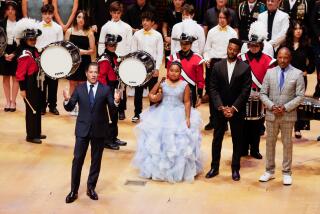Magnet School to Put Special Focus on Math
- Share via
Mound School in Ventura is preparing to become a math magnet school this fall, making it the first public school in Ventura County to specialize in an academic subject.
Under a plan that the Ventura school board is expected to approve next month, Mound teachers will put special emphasis on mathematics, weaving it into their instruction of all other subjects during the school day.
The plan to become a magnet school is part of Mound’s response to a federal civil rights investigation last year that found the primarily white school was not doing enough to attract minority students.
Mound officials hope that a beefed-up math curriculum would help entice Latino parents whose children are interested in math to transfer from their neighborhood schools.
Of Mound’s 550 children, about 90% are white, a far higher proportion than the 60% white enrollment in the Ventura Unified School District as a whole.
A probe by the U. S. Department of Education’s Office for Civil Rights ended last fall with school officials agreeing to encourage minority parents to enter their children’s names in Mound’s annual admissions lottery and to give preference to minority youngsters in the drawing.
Also, Mound officials agreed to offer some unique educational program that might lure minority students from around the city.
“There are talented students all over the district in math,” Assistant Supt. Patricia Chandler said. “We’re hoping--once we make it really clear that we’re taking a specific-subject approach--it will attract students from all over the district regardless of their ethnicity.”
Mound School opened in 1988--after being closed for several years--as the Ventura district’s first year-round school.
Enrollment was opened to all families who preferred a non-traditional school calendar, making Mound the only school in Ventura without a particular attendance area from which it draws students.
As such, Mound has no bus transportation, requiring parents to bring their children to and from school.
From its inception, Mound attracted teachers who were excited by the school’s year-round calendar and parents who were willing and able to drive their children to school.
And that combination of strong teachers and highly involved parents helped earn the school a reputation as one of the best in the district.
But four other Ventura elementary schools converted to year-round calendars in recent years, so school officials began to consider a magnet program for Mound.
Mound needed an alternative educational program to justify its continued open-enrollment policy as well as to to attract minority students, Chandler said.
So beginning in the fall, Mound plans to adopt a curriculum developed by the University of Chicago that weaves math into the instruction of other subjects, such as science and social studies.
“We’re going to be trying to integrate it into the whole day, to relate it to their everyday lives, “ said Mound teacher Susan Frank, one of two teachers who piloted a Chicago program in two classes this year.
The district chose math, officials said, because of the success that Frank and her colleague have had with the new curriculum this year.
*
With the new curriculum, Frank said her third-graders have progressed further in math than classes in previous years, making them comfortable discussing prime numbers, square roots and other concepts that are usually introduced to older students.
“The concepts we’ve gone over have been way beyond anything I’ve ever taught before,” she said.
With no math textbooks, the program represents a shift from the traditional emphasis on rote learning of long division and other subjects. Instead, Mound students will learn math primarily from hands-on classroom activities, games such as dominoes and word problems that challenge students to apply arithmetic to their everyday lives.
Frank, for instance, did not formally teach the multiplication tables this year.
But the students had to learn their multiplication tables to be able to do other activities, such as play a classroom bingo game that uses multiplication.
“It really is completely different from the way that I’ve taught math before,” Frank said.
Another difference from traditional math programs is that new concepts are reintroduced repeatedly throughout the year to reinforce learning.
“Before when you taught math you taught one concept, like decimals, you taught it and then you seldom came back to it,” Frank said. “This program spirals. You introduce a concept, then you go on. Then you bring (the concept) back.”
More to Read
Sign up for Essential California
The most important California stories and recommendations in your inbox every morning.
You may occasionally receive promotional content from the Los Angeles Times.













